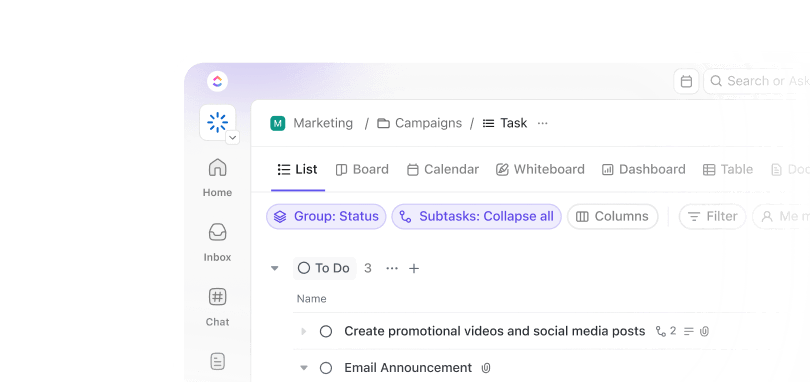Modern workplaces have made communication a necessity. With dispersed teams and hybrid work models, there is a growing need for boundaryless information sharing. Against this backdrop, a company intranet is the backbone of workplace communication and collaboration. 🔗
If you’re thinking of the intranet site as static directories or boards sharing company news, those are a thing of the past.
Modern company intranets are dynamic platforms that promote employee engagement, team collaboration, innovation, and efficiency.
In this article, we dive deep into the world of company intranets, using examples across industries to illustrate how the corporate intranet is breaking the mold of its traditional counterpart. Read on to discover how company intranets are transforming workflows, setting new standards of teamwork, and bridging gaps with seamless connectivity. 🌟
⏰ 60-Second Summary
- A company intranet fosters collaboration, enhances workplace communication, and enriches company culture
- The corporate intranet improves employee communication and collaboration, drives engagement, diversifies communication channels, and improves productivity
- Setting up an intranet requires various tools and software for managing communication, content, security, etc.
- Understand how companies in finance like Goldman Sachs and nonprofit like UNICEF use a company-wide intranet to keep employees in the loop
- Some best practices while choosing an intranet: regularly update the resources, offer training material to employees, use interactive elements like polls and surveys, focus on design and accessibility
- Use , the everything app for work that serves as your organization’s centralized brain. Use it for internal comms and engagement. Docs, Brain, Tasks, and Dashboards, make it a game-changer to enhance workflows within an intranet ecosystem
10 Company Intranet Examples to Boost Collaboration
What Is a Company Intranet?
A company intranet is a private, centralized digital network connecting employees. Think of it as a small-scale, localized internet for a company designed exclusively for internal use. Fundamentally, it is a secure hub for essential resources, a platform for team collaboration, and a source of the latest information.
The typical intranet site features employee portals, project management tools, document management, and social networking elements that connect employees and keep them productive.
At the same time, it aims to provide a feeling of community and belonging that enriches the company culture.
What is available on the company intranet?
As a central hub for all things company-related, the corporate intranet’s content typically fits into several categories.
Here are the things you’d typically find on the intranet:
- Analytics and dashboard: Insights into team and individual productivity, engagement levels, and resource utilization 📶
- Company news and updates: Centralized announcements to keep the entire company informed and engaged 🚨
- Knowledge repositories: Access to standard operating procedures (SOPs), FAQs, training materials, and other critical knowledge management resources 📚
- Project collaboration tools: Shared workspaces to manage tasks, collaborate on documents, share feedback, and more 🤜🤛
- Employee resources: Onboarding material for new employees and details related to employee policies, benefits information, employee directory, employee recognition programs, etc. 🛠️
- Employee communication channels: Instant messaging, forums, social intranet, and discussion boards to enhance employee engagement through seamless company-wide interaction 📢
- HR tools: Shift schedules, company calendar, leave management, career development resources, feedback mechanism, and more 📝
🔎 Did You Know? The Department of Defense’s ARPANET is the first Intranet developed in the 1960s and 1970s. It connected Department of Defense computers, improving usability and enhancing their capabilities—a groundbreaking step in the evolution of digital communication!
Why Is a Company Intranet Important?
When you have the world of the internet at your fingertips, what does corporate internet bring to the table? Well, here’s what it has to offer:
🔮Streamlined internal communications
The corporate intranet is a central hub for all internal communications. It makes relevant information, announcements, updates, and critical resources available without sifting through lengthy email trails.
🔮Diversified collaboration
The corporate intranet features several alternatives to email: instant messaging, discussion boards, forums, collaborative tools, and more. The mix of such channels makes the digital workplace more engaging while supporting real-time, collaborative decision-making.
🔮Increased productivity
The company intranet grants employees access to all resources, from company policies to training and onboarding materials. Regardless of the communication channels, this saves them time and effort and boosts productivity and efficiency.
🔮Strengthened company culture
The corporate intranet cultivates a sense of community by encouraging employees to connect. Social intranet features, such as forums, employee recognition tools, and shared interest groups, engage employees and create a thriving work environment.
🔮Improved decision-making
By functionality, company intranet platforms bring everyone on the same page. They also make information and resources readily accessible.
When paired with a data analytics platform, visibility, transparency, and accountability generate actionable insights that improve real-time decision-making.
Curious to learn how AI can help you create a robust knowledge management system? Check out the video below:
Top 10 Company Intranet Examples
Here are some real-world modern company intranet examples used in different industries across the world:
1. Goldman Sachs’ Secure Collaboration Hub (Finance)
As a leader in the financial sector, Goldman Sachs’ intranet design focuses greatly on security.
The network spanning multiple countries allows seamless collaboration while adhering to strict compliance requirements across geographies. It integrates financial modeling tools, real-time data sharing, and policy updates to enhance workflows.
Key features of a finance company intranet:
✅ Allow secure storage and sharing of sensitive and confidential financial data
✅ Automate compliance updates and policy tracking
✅ Provide real-time access to market trends and analytics, along with financial reports
✅ Integrate with financial modeling and forecasting tools
✅ Share timely updates across different communication channels
2. Google’s MOMA Intranet (Technology)
MOMA, Google’s corporate intranet, is a gold standard for functionality and innovation. Built on Google’s proprietary technology, the intranet site is designed to facilitate seamless communication and optimize productivity throughout its global workforce.
MOMA features a powerful search engine, customized dashboards, and AI-powered insights that reflect the company’s commitment to constant innovation.
Key features of a tech company intranet:
✅ Encourage innovation through collaborative brainstorming and problem-solving tools
✅ Grant access to technical documentation and coding resources
✅ Integrate with project management and bug-tracking solutions
✅ Offer dashboard customizations to track performance and resources
✅ Provide real-time visibility into project status, stakeholders, dependencies, and other details
3. Cleveland Clinic’s Employee Portal (Healthcare)
Cleveland Clinic’s intranet site is designed to meet the demands of a healthcare environment. It focuses on four core elements: improving patient outcomes, enabling cross-functional team collaboration, making healthcare data shareable, and complying with HIPAA guidelines.
For this reason, you’ll notice real-time case updates, training modules, and other tools and resources to encourage employees to provide exceptional patient care.
Key features of a healthcare company intranet:
✅ Facilitate secure access to patient records, diagnostic data, and clinical details
✅ Offer training modules and access to the latest developments for medical staff and frontline workers
✅ Centralize clinical guidelines, healthcare protocols, and emergency procedures
✅ Enable team collaboration for discussing patient cases and treatment plans
✅ Optimize schedules and shifts for healthcare teams to increase employee productivity
4. Walmart’s OneWalmart Intranet (Retail)
OneWalmart is a modern intranet platform that connects global Walmart associates. It features scheduling tools, training resources, and communication channels to ensure that all associates can discharge their duties.
OneWalmart also has a feedback portal, boosting employee engagement and involvement and promoting a cohesive company culture.
Key features of a retail company intranet
✅ Simplify shift management and employee scheduling
✅ Centralize training materials for store associates
✅ Provide real-time updates on inventory, promotions, and other campaigns
✅ Offer tools for employee engagement and feedback across stores
✅ Incorporate with point-of-sale systems for effective reporting on financial data
5. Harvard University’s my.Harvard Intranet (Education)
Harvard University’s my.Harvard intranet is a comprehensive platform for students, faculty, and staff.
This intranet example integrates academic resources, administrative tools, and communication features to cater to the university’s diverse needs. It also has a dedicated section on using this intranet homepage through how-to guides.
Intranet users log in using their HarvardKey and easily access their schedules, grades, and other information.
Key features of an education intranet solution:
✅ Provide access to course materials and knowledge bases
✅ Boost communication between students, faculty, and administration
✅ Support registration and grading through automated workflows
✅ Centralize school/university policies, announcements, event schedules, etc.
✅ Offer collaborative tools for group projects and academic discussions
💡 Pro Tip: Always equip your intranet with dedicated business communication channels to reduce scattered communication. An exhaustive communication platform within your intranet fosters clarity, boosts productivity, and keeps your team connected, no matter where they are.
6. General Electric’s Intranet (Manufacturing)
General Electric’s intranet design is built to support the complex needs of the global manufacturing leader.
It is a digital workplace for engineering teams, production staff, and administrative departments, offering advanced tools for knowledge sharing, process standardization, and collaboration.
Key features of a manufacturing company intranet:
✅ Centralize production protocols, SOPs, and safety guidelines
✅ Share real-time updates on inventory and raw material levels and supply chain status
✅ Enable collaboration across engineering and production teams
✅ Streamline compliance management and preventive maintenance with automated tracking
✅ Support knowledge sharing through industry forums, innovative campaigns, and resources
7. BBC’s Staff Portal (Media)
The BBC Staff Portal intranet unifies its diverse workforce of journalists, producers, technical staff, and remote workers. It brings internal communications, establishes editorial guidelines, and schedules features—all on one platform—to meet the media industry’s dynamic requirements.
Through this company intranet homepage, BBC fosters collaboration and keeps employees informed of breaking news or internal updates.
Key features of a media company intranet:
✅ Consolidate editorial guidelines and publishing workflows
✅ Enable real-time collaboration for breaking news and live telecast coordination
✅ Support scheduling and resource allocation for media projects
✅ Provide tools for managing historical content and archives
✅ Encourage collaboration across creative, editorial, and technical teams
8. Marriott’s Marriott Global Source (Hospitality)
Marriott Global Source (MGS) is an intranet portal that is a key global resource for hotel staff.
The intranet provides tools for efficient property management, imparts customer service training, and implements the internal communication strategy. This lends consistency to the service delivery, regardless of the location, and delivers operational excellence.
Key features of a travel/hospitality company intranet:
✅ Simplify property and reservation management for staff
✅ Supply onboarding training resources to ensure service consistency
✅ Centralize guest feedback and satisfaction tracking
✅ Cultivate seamless communication between properties and corporate offices
✅ Enable shift management and employee engagement initiatives
9. UNICEF Intranet (Non-profits)
UNICEF’s intranet supports the organization’s mission-driven work. It connects staff and volunteers worldwide and equips them with project management tools to manage tasks, manage resources, and share real-time updates on ongoing campaigns.
As such, the intranet establishes an environment of transparency and collaboration, keeping the UNICEF team aligned.
Key intranet features for non-profits:
✅ Manage resources centrally for effective campaign planning and execution
✅ Share real-time updates on project progress and funding status
✅ Set up collaboration between office staff and on-field volunteers
✅ Simplify onboarding and training for new members
✅ Support reporting and analytics for donor transparency
10. Shell’s The Hub Intranet (Energy)
Shell’s The Hub is tailored to the energy industry’s dynamic requirements.
The intranet integrates tools for compliance management, safety training, and global internal communications, making it the backbone of the company’s geographically dispersed workforce. It also promotes knowledge sharing and innovation across its operations.
Key features of intranet software in the energy sector:
✅ Centralize safety training and document compliance measures
✅ Provide real-time updates on field activities and operations
✅ Enable collaboration on engineering and environmental projects
✅ Allow knowledge sharing for research and innovation
✅ Set up communication across geographically dispersed teams
Setting up a functional and efficient corporate intranet requires diverse tools depending on your organization’s specific needs. These tools typically fit broad categories to ensure seamless functionality and usability while emphasizing platform reliability.
This is where helps out as a powerful solution for internal communication and collaboration.
Its versatile features, such as Docs, Brain, Tasks, and customizable Dashboards, make it a game-changer for enhancing workflows and maximizing efficiency within an intranet ecosystem.
Here’s a list of the tools you usually need to set up a company intranet:
🚀 Business communication software
You’ll need business communication software to facilitate real-time collaboration and interaction. This software allows teams to interact through instant messages, video calls, group discussions, and other methods to bridge communication gaps across departments or locations.
acts as an internal communications manager and provides a centralized space for communication, eliminating the need for scattered emails or disjointed messaging platforms.
For instance, Chat reduces email overload and allows you to host individual or group conversations directly within your intranet. Teams can also stay connected through comment threads, mentions, and task discussions.
This unified communication ensures that everyone stays on the same page, regardless of location or role, making it an indispensable part of any company intranet. ✅
🚀 Document management tool
The intranet content should be centralized to establish a single source of truth. Effective document management tools allow intranet users to upload, organize, search, and share files across a secure network. This makes information accessible and fosters efficiency and transparency.
You may also need a Content Management System (CMS) to update these data repositories.
Docs transforms your intranet into a dynamic knowledge-sharing platform. Create and store documents (project scope, SOPs, policies, etc.) that can be edited live, shared with team members, and linked to tasks. ✅


Whether drafting a proposal, documenting internal processes, or brainstorming ideas, Docs offers seamless integration with tasks. This allows users to turn ideas into actionable steps from the document directly.
Such features save time and ensure that all vital information is readily accessible and easy to update. ✅
🚀 Task and workflow management tools
Routine and repetitive tasks drain productivity. A tool that automates such tasks helps streamline workflows. From assigning tasks to obtaining approvals, automation tools save time and effort while improving accuracy.


At the core of ’s functionality are its comprehensive task management features. Teams create, assign, and prioritize tasks, ensuring every project stays on track.
Moreover, ’s customizable workflows allow each department to adapt the tool to specific needs, such as managing content approvals, tracking development sprints, or organizing company events. As a result, bottlenecks are reduced, enabling smoother execution across the board. ✅
🚀 Employee engagement tools
In the modern intranet, employee engagement tools are a feedback mechanism. They include features like surveys, polls, recognition programs, and social intranet software capabilities to improve employee engagement, participation, and morale. These tools create a sense of community and belonging and promote collaboration within the intranet.


is a great choice for employee engagement software. It offers critical features for hiring, onboarding, and employee development.
With an array of HR-focused tools and templates, such as employee engagement surveys, standard operating procedures (SOPs), performance reviews, and action plans, equips organizations with the tools to improve employee engagement and satisfaction. ✅
🚀 AI and automation
AI and automation are essential for modern intranets. They optimize repetitive tasks, enhance workflows, and provide intelligent insights to improve decision-making.
Intranets become more efficient by automating processes like onboarding, training, and task management. This frees employees to focus on strategic initiatives and creates greater organizational productivity.
Brain capabilities are designed to streamline repetitive processes and enhance decision-making. Automating routine tasks like training workflows, onboarding procedures, or recurring project updates allows teams to focus on more strategic initiatives.
Brain also transforms knowledge management by providing robust tools to document, share, and instantly access company information using AI. From prebuilt wiki templates to AI-powered answers, Brain ensures your team can effortlessly store and retrieve knowledge whenever needed.
This AI-powered assistant also drafts content, analyzes trends, and suggests optimizations, giving your intranet the benefit of intelligent support. ✅
📮 Insight: About 43% of workers send 0-10 messages daily.
According to research by , while sending 0-10 messages a day suggests more focused or deliberate conversations, it could also indicate a lack of seamless collaboration and the need to hunt for important information across multiple locations, like email.
To prevent unnecessary platform hopping and context switching, try , the everything app for work. Gain a centralized knowledge hub of information within its context that is also completely searchable.
🚀 Data analytics and reporting tools
Every intranet software must feature data analytics and reporting tools to meet its intended goals. These tools track user activity, intranet adoption rates, engagement metrics, resource utilization, and other metrics to refine the intranet.
Dashboards provide real-time insights into team performance, project timelines, and resource allocation.
In the context of an intranet, these Dashboards become a vital tool for managers and employees alike, offering a visual representation of progress and priorities. Whether you’re tracking the status of training modules, monitoring resource utilization, or analyzing key metrics, Dashboards ensure you have the data you need to make informed decisions. ✅
🚀 Search and navigation tools
User-friendly search and navigation tools enable users to locate information, even if it’s spread across intranet pages. Intranet platforms with robust search and navigation capabilities improve overall productivity and satisfaction.
’s Connected Search is a game-changer for intranet functionality. It enables users to instantly locate tasks, documents, conversations, and other resources across the platform.
This powerful feature eliminates the time spent searching through scattered files or communication threads, ensuring employees can easily access the necessary information. ✅
🚀 Security and access management tools
The intranet should safeguard sensitive data. To this end, it should have security features such as user authentication, role-based access, data encryption, and more to protect the platform, resources, and data.


secures your data with strong privacy measures, including encryption, advanced access controls, and compliance with industry standards like GDPR and SOC 2. These safeguards protect sensitive information, making a trusted choice for secure collaboration and resource management.
Best Practices for Maintaining Your Company Intranet
Now that you know all that there is about corporate intranets, let’s look at some best practices to make it valuable:
Here are some tips and practices to ensure a safe company-wide-intranet:
- ✅ Keep the intranet pages and their content fresh by updating company news, resources, and announcements frequently
- ✅ Use polls, forums, surveys, and recognition tools to keep employees engaged and encourage interaction and participation
- ✅ Offer tutorials, how-to guides, and other resources to provide ongoing training and support to employees
- ✅ Use analytics to track employee feedback and engagement, identify issues and bottlenecks, and improve the intranet functionality
- ✅ Embrace a responsive intranet design for compatibility with all mobile devices to provide on-the-go accessibility
- ✅ While designing the intranet, consider accessibility. Make provisions for assistive tools such as screen readers and color contrast
- ✅ Implement robust security measures, such as end-to-end data encryption, multi-factor authentication, single sign-on, etc., to protect sensitive information
Setting Up Smart Intranet Solutions With
A modern intranet is a vital thread that connects employees. It promotes collaboration, sets up data repositories, supports decision-making, and reinforces company culture. 🖇️
Build your company intranet with business communication software, document management tools, task and workflow automation tools, employee engagement tools, search and navigation tools, data analytics and reporting tools, and security and access management tools.
Alternatively, you can condense everything into a single platform——that offers everything you need to build and maintain a smart and modern intranet for your company.
Sign up for and explore how to set up a smarter and more connected intranet for a digital workplace. 🏆


Everything you need to stay organized and get work done.












.jpg)



